
The Yarf! reviews by Fred Patten
Note: This is a fraction of the entire listing. If you’re on broadband, you might want to try the high speed version instead.

The Yarf! reviews by Fred Patten
Note: This is a fraction of the entire listing. If you’re on broadband, you might want to try the high speed version instead.
Welcome to the “Patten’s reviews” wing of the Anthro Library! Since this is a collection of columns from a dormant (if not dead) furzine called YARF!, a word of explanation might be helpful: In its day, YARF! (aka ‘The Journal of Applied Anthropomorphics’) was perhaps the best-known—and best in quality—of furry zines. Started in 1990 by Jeff Ferris, YARF!’s roster of contributors reads like a Who’s Who of furdom in the last decade of the 20th Century. In any issue, the zine’s readers could expect to enjoy work by the likes of Monika Livingstone, Watts Martin, Ken Pick, and Terrie Smith; furry comic strips such as Mark Stanley’s Freefall… and Fred Patten’s reviews of furry books and comics.
Unfortunately, YARF! has been thoroughly inactive since its 69th issue, which was released in September 2003. We can’t say whether YARF! will ever rise again… but at least we can prevent its reviews from falling into disremembered oblivion. And so, with the active cooperation of Mr. Patten, Anthro is proud to present Mr. Patten’s review columns—including the final one, which would have appeared in the never-printed YARF! #70.
Full disclosure: For each reviewed item, we’ve provided links you can use to check which of four different online booksellers—Amazon.com
, Barnes & Noble
, Alibris
, and Powell’s Bookstore—now has it in stock. Presuming the item in question is available, if you buy it Anthro gets a small percentage of the price.
 #38 / Sep 1995 |
||||
|
|
|
|||
|
|
|
|||
|
|
|
|||
| The Crimson Bears series, by Tom LaFarge | ||||
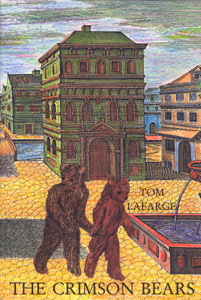 |
||||
| Title: | The Crimson Bears, Part I | |||
| Illustrator: | Wendy Walker | |||
| Publisher: | Sun & Moon Press (Los Angeles, CA), Apr 1993; 2nd printing, Feb. 1995 | |||
| ISBN: | 1-55713-074-4 | |||
| 272 pages, $12.95 | ||||
| Availability: | Am |
|||
|
|
||||
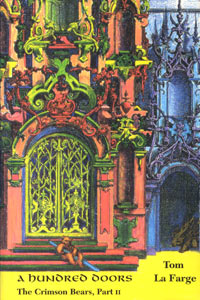 |
||||
|
|
||||
| Title: | A Hundred Doors (The Crimson Bears, Part II) | |||
| Publisher: | Sun & Moon Press (Los Angeles, CA), Feb 1995 | |||
| ISBN: | 1-55713-192-9 | |||
| 228 pages, $12.95 | ||||
| Availability: | Am |
|||
2007 editor’s note: In its initial 1995 appearance, this review contained information on where to order The Crimson Bears and A Hundred Doors from. Since this information is no longer accurate or relevant, it has been deleted from the current presentation.
Edgar and Alice, brother and sister, one morning set out from their room to walk across an entire country. Their room was in the City of Bears, and they were bears; Edgar a dark brown, Alice more russet; they were both about half grown. The country they were to walk across was called the Commonwealth of Bears […] (pg. 7)
Edgar and Alice are two young innocents. The City of Bears is the major city of the bears, and they have grown up comfortably surrounded by bears. They have left home to visit their Uncle Claudio in Bargeton, in the far East of the bear nation. Bargeton is an ancient city near the confluence of several animal peoples, and the newest metropolis of the bears, having been conquered only three generations previously. Claudio is the leader of Bargeton’s Senate, and the young siblings expect to spend a pleasant vacation. Instead, they are swept into a maelstrom of Renaissance-Italianate politics amidst a variety of animals unfamiliar to them, as different factions seek to win their friendship to gain their uncle’s favor, or to seize them as hostages.
The two volumes of The Crimson Bears are published as volumes 26 and 31 of The New American Fiction Series. They are self-consciously literary—which is not a bad thing when it is done well, as it is here. The writing style is leisurely, emphasizing rich description rather than action. Almost two pages are devoted to Claudio’s ornate robe of office alone:
Nature’s forces at their violent work were embroidered in many places. […] Across one shoulder a fire ate a forest, sending up overlapping billows of silver needlework, and threatening a city hard by the collar. The fleeing inhabitants, blue weasels, were caught in postures of dismay by sure feather-stitches. On the left pocket fat clouds, rimmed with violet bullion-knotting, shed snow on roebuck, who watched their grazing disappear. […] By the banks of the great watercourse that tumbled down the right sleeve Alice could find: seven dog-sages laughing by a pool; a fishing rhinoceros; a baboon stepping into a boat just above a waterfall. […] (pgs. 24-25)
There are similarly intricate word-portraits of fantastic mansions, ornate gardens, market squares teeming with animal merchants, ominous subterranean crypts, and much more. LaFarge’s imagination starts on a level equal with the architects who designed the pleasure palaces for Louis XIV and Ludwig II, and escalates to the macabre splendor of Peake’s Gormenghast castle.
The narrative is a savory stew of antique literary styles. The Clowncats, dissolute descendants of the former feline rulers when Bargeton was known as Concatenopolis, affect the florid rhetoric of 18th-century melodrama:
Then the cat was on his feet. He swept the bonnet from his head and made them a courteous bow.
“Have no fear,” were his first words to them, “although the place be something tenebrous and vasty-gloomy, yet we may shed light of cheer in it by changing loving greetings.” (pg. 113)
The lizardish Ceruk are a melancholy species, given to mercantilism and Shakespearean tragedies. A Ceruk father-to-be, boasting of his wife’s newly-laid eggs to his rivals:
Ha! Tread lightly, you who throng the narrow space
Around the sand, for here’s a fearful clutch of eggs
To beat you back, to jostle past you in the press,
To wedge between your longest-nursed affairs and you!
Ten eggs! Ten sons! Ten brothers raised to handle gold,
Ten wits and twenty arms, one undivided mind,
One single purpose, to extend the fortunes of their house. […] (pg. 194)
Unlike many novelists whose attempts at old-fashioned writing are shallow and error-filled, LaFarge provides lengthy passages which show his mastery of each of these styles and create a genuine exoticism. He also knows just how much to use, and when to get on with the story. (Sometimes humorously, as when one cat interrupts another to tell him to cut short the tedious bomphiology and get to the point.)
There is also a strong ’morphic atmosphere. A key subplot revolves around the status of the Ceruk as the most recently evolved of the speakable animals, who still often have unintelligent offspring. An elaborate social code has evolved around how they must treat children who are dumb animals, and how intelligent Ceruk born to feral animals are recognized. This becomes a corkscrewishly twisted lever in the deadly legalistic interplay. Little tidbits are scattered throughout, such as an offhand comparison between caribou and beaver cookbook recipes (of equal disinterest to a carnivore).
But The Crimson Bears is by no means all wordplay and no action. Edgar and Alice arrive in Bargeton on the eve of an attempted coup which turns into a bloody free-for-all civil war among at least eight different factions. The bears are caught in the midst of rioting, conflagration, murders, and an invading army. The two-volume novel is filled with lavishly described dramatic scenes that cry out for a fantasy artist like Don Maitz or Thomas Kidd to paint them. This is definitely worth reading—although at $26.00 for the two volumes, you may want to have your local library order it. ![]()
| The Woodstock Saga, by Michael Tod | ||||
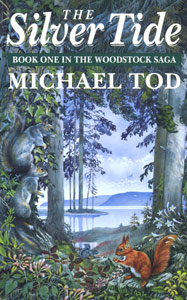 |
||||
| Title: | The Silver Tide (The Woodstock Saga, Book One) | |||
| Illustrator: | ? (maps) | |||
| Publisher: | Orion Books (London) | |||
|
|
||||
| ISBN: | 1-85797-563-4 | |||
| Hardcover (Apr 1994), 226 pages, £9.99 | ||||
| Availability: | Am |
|||
|
|
||||
| ISBN: | 1-85797-319-4 | |||
| Paperback (Nov 1994), 226 pages, £4.99 | ||||
| Availability: | Am |
|||
|
|
||||
 |
||||
|
|
||||
| Title: | The Second Wave (The Woodstock Saga, Book Two) | |||
| Illustrator: | ? (maps) | |||
| Publisher: | Orion Books (London), Nov 1994 | |||
| ISBN: | 1-85797-367-4 | |||
| xi + 244 pages, £12.99 | ||||
| Availability: | Am |
|||
Stephen Jones and Jo Fletcher reported in Science Fiction Chronicle, December 1993:
Publishing mogul Anthony Cheetham just happened to be a guest of BBC Radio Wales’ book programme And Now Read On at the same time as frustrated first-time novelist Michael Tod. Mr. Tod spent some time regaling listeners with his all-too-familiar tale of woe: he’d writen a novel, The Silver Tide, a sort of squirrel version of Watership Down, but couldn’t find anyone to publish it. As his conservatory-designing business had been hit by the recession and he was stony broke, he raised capital by selling shares in the book to family and friends and published the volume himself. The financial constraints were such that, picking up the last consignment from the printers, he ran out of petrol and had to stop at a friend’s house and sell him copies of the book so he could get home. Local booksellers were duly impressed with his talent and took more than 1,000 copies. Mr. Cheetham was also impressed, and bought the book itself, as well as two sequels. So who says publishers never listen? Look out for The Silver Tide in mass-market format in January. (pg. 38) [It was April.]
Watership Down is a hard act to follow. but Tod’s trilogy comes close enough to put him solidly in the ranks of the better British ‘nature novelists’ along with Richard Adams, William Horwood, and Garry Kilworth.
In The Silver Tide, a community of native red squirrels in Purbeck, in Dorset on the Channel coast, is confronted by a wave of larger, aggressive American grey squirrels spreading throughout Britain, or ‘New America’ as they call it. The peaceful red squirrels do not know how to react to the arrogant grey squirrels, whose attitude seems similar to the stereotype of the American settlers who considered the native Americans a “decrepit bunch of savages” (pg. 80) who did not deserve the land that they lived upon. After one of the Reds of Blue Pool is killed, the others regretfully abandon their ancestral land and begin a trek to find a new home—if there is anyplace in Britain where Reds can live which the Greys will not eventually take over.
But the story is much more complex than this. The Greys do not fight only with their teeth and claws; they have Stones of Power:
His queasiness increased and he had some difficulty in focusing his eyes. When his vision cleared he saw that the Greys were arranging a square of stones at the base of his tree. There were ‘lots’ of stones, certainly more than eight. He tried to count again. For some reason, it seemed to be important to know how many stones there were.
[…]
The Grey, Quartz, came forward and put his forepaw on one of the corner stones. Juniper’s whiskers instantly buzzed and tingled, much worse than before, and his body started to shake uncontrollably.
The Grey lifted his paw and the buzzing and shaking stopped. Juniper hung limply out of the drey coughing and retching, his head aching intolerably. (pgs. 66-67)
The Greys have learned how to manipulate Earth power; the primal force controlled through Leylines, pyramidology, and similar metaphysical practices. The Reds have their own power through their worship of the ‘life-giving Sun’. The Greys’ Stone Power is more immediate and obvious, but the Reds’ prayers to the Sun are also answered in a more subtle way.
As with Watership Down, The Woodstock Saga builds up colorful cultures for the squirrels. The Reds have plant names: trees for the males (Oak, Rowan, Larch, Chestnut) and flowers for the females (Burdock, Bluebell, Meadowsweet). The Greys all have harsh mineral names (Flint, Marble, Granite, Chert). But the cultures are not uniform within each species. One refuge which the Blue Pool Reds find is already settled by a tribe of Reds who have a monarchical caste system, and the two Red societies clash. In The Second Wave, a group of Greys who are willing to embrace the Sun faith unfortunately fall under the influence of a Red fanatic who has perverted their gentle nature religion. He turns the Greys into a Crusading army to slay all Red ‘degenerates’ who do not agree with his decrees of harsh penance for their ‘sins’. So what at first seems to be a conflict between two colors of otherwise-identical squirrels turns out to be much more interestingly complex.
The biggest annoyance about Tod’s writing is an overuse of coincidence and divine intervention. The Reds’ young intellectual, Bright Marguerite, ‘invents’ counting just in time to figure out a defense against the Stone Power. Why do prayers to the Sun work so well for the Reds of Blue Pool, but apparently not for other Reds? If prayer were as efficacious as it seems here, the divinity of the Sun and the ‘right way’ to worship ought to have become obvious to all squirrels long since. However, the novels have enough merit to make this minor flaw tolerable. Tod is a new author, with at least one more novel in his trilogy to come. Hopefully his writing will mature to match his imagination. ![]()
 #39 / Nov 1995 |
||||
|
|
|
|||
|
|
|
|||
|
|
|
|||
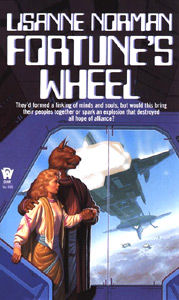 |
||
| Title: | Fortune’s Wheel (The Sholan Alliance, vol. 2) | |
| Author: | Lisanne Norman | |
| Publisher: |
DAW Books (New York, NY), Aug 1995 |
|
| ISBN: | 0-88677-675-9 | |
|
646 pages, $5.99 |
||
| Availability: | Am |
|
This sequel to Norman’s Turning Point (reviewed in Yarf! #29) is a big surprise in several respects. Literally; at 646 pages, it is almost 21/2 times the size of the first novel’s 267 pages. That story stood nicely on its own, although there was a strong hint that a sequel might be coming. Fortune’s Wheel is clearly labeled as Book #2 in “Lisanne Norman’s sensational new DAW science fiction series!”, and it does not stand on its own. It ends on a cliffhanger, with enough unresolved plots and subplots to fill two or three more volumes, at least.
Turning Point is a nice space-opera updating of Beauty and the Beast. Carrie Hamilton is a young woman on Keiss, a male-dominated Terran colony planet which was conquered by brutally hostile aliens, the Valtegans, a few years earlier. A human resistance movement has grown up, but none of the men take Carrie seriously when she wants to help. Carrie nurses a wounded catlike wild animal back to health; he turns out to be Kusac, a disguised handsome felinoid from a scoutship of the Sholans, an unknown alien species which is also at war with the Valtegans. Kusac is the scout party’s telepath, so he has no trouble recognizing Carrie’s inner strength and her own latent telepathic powers. Carrie helps Kusac return to his shipmates, and aids him in bringing the Terrans and Sholans into an alliance to overthrow the Valtegans. The novel ends with Keiss liberated, and Carrie as Kusac’s telepathically-linked lifemate who is about to return with him to Shola to meet his family.
It was obvious that any sequel would involve the culture shock that both Carrie and the Sholans must go through as she becomes the unofficial representative of humanity on a planet of intelligent cat-people. That is actually just the starting point for several unexpected developments.
Fortune’s Wheel begins deceptively blandly, as little more than an imitation of McCaffrey’s & Nye’s Doona novels, with humans and extremely human-like felinoids learning to get along in a mutual alliance. The opening scenes even seem to have regressed from the exotic atmosphere of Turning Point, where the Sholans were introduced as an intriguingly mysterious furry & fanged people. Fortune’s Point’s depiction of a Sholan space battle fleet is no different from hundreds of s-f human military spaceships, except that the uniformed crews are described as twitching their whiskers and ears and swishing their tails. Carrie’s first impression of the Sholans is similar; they seem like little more than furry humans. It takes time for the differences to begin to develop—and they are differences which surprise not only Carrie, but also the Sholans! (Unfortunately, more details cannot be given without spoiling some of the surprises.)
Carrie is only one of several important characters, both human and Sholan, in this much larger novel. She and Kusac Aldatan may be mind-bonded lovers, but they are also nervous about their unique relationship, and partly resentful towards the telepathic compulsion which would force them to remain united even if they did not love each other. Kusac’s family and friends react in different ways to his bringing home an alien mate. Factions within both Shola’s political and religious hierarchy must decide whether the human/Sholan bonding is natural or perverted; to be encouraged for interstellar friendship or stamped out to preserve Shola’s social stability. A couple of the sub-plots get so involved with existing Sholan politics that Carrie and Kusac are almost incidental to them.
One of the first sub-plots is unfortunately also one of the weakest. Norman tries to create some suspense almost immediately by making Carrie the target of murderous isolationists who fear all aliens, while most Sholans are overjoyed by the news that a friendly new space people have just been discovered who will help them fight the Valtegans. Granted that any large social group will have its lunatic fringe, this cell of terrorists snaps together unconvincingly swiftly; and its rationalizations for not believing the Sholan government’s press releases describing the Terrans’ aid seem exaggeratedly paranoid.
Fortune’s Wheel does carry one major plot through to its conclusion, so this book ends satisfyingly even though there are numerous questions left unanswered. The cliffhanger implies that the Valtegans will return in the next novel, and there are many other sub-plots to be resolved. ![]()
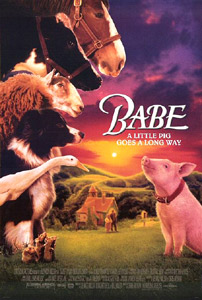 |
||
| Title: | Babe (movie) | |
| Screenplay: | George Miller & Chris Noonan (from the novel by Dick King-Smith) | |
| Cast: | James Cromwell, Magda Szubanski, (voices of) Christine Cavanaugh, Miriam Margolyes, Danny Mann, Hugo Weaving | |
| Crew: | Chris Noonan (director); George Miller, Doug Mitchell, Bill Miller (producers); Andrew Lesnie (cinematography); Nigel Westlake (score) | |
|
Universal (4 Aug, 1995), 91 minutes |
||
| Availability: | Am / BN / Al / Pw | |
1995 has been a good year for live-action movies about talking animals. There is Fluke, which may be the first serious adult-oriented drama about talking animals rather than a comedy. And now there is Babe, which is a comedy (based upon a children’s novel by Dick King-Smith) but a gentle, intelligent one rather than going for low farce. (There is also Gordy, which I haven’t seen yet but which has gotten mostly unfavorable reviews.)
Babe is also an exciting demonstration of the movie industry’s ability to create convincing talking animals. Until recently, this was not a serious concern. Talking animals were only for laughs, and any crude simulation of an animal spouting witticisms was considered good enough. There have been live-action comedies with animals with animated mouths since the 1940s (Jerry Fairbanks won the Academy Award for Best Short Subject in 1942 and 1944 for his Speaking of Animals one-reelers), but there was no attempt to disguise the fact that these were cartoon lips superimposed onto the faces of unintelligent animals. In movies such as the Francis the Talking Mule series or The Shaggy Dog, the emphasis was not on the animal characters as much as on the human leads. The animals were just the catalysts to keep the human highjinks moving. It has only been since Who Framed Roger Rabbit? in 1988 that producers and directors have had to create sympathetic non-human stars who must be as convincing to the audiences as the human cast.
Both Babe and Fluke (released just two months earlier) feature superbly-directed animal casts. They imply by their body-language that they really are conversing with each other. But in Fluke the animals talk telepathically, so there is no need to show plausible mouth movements. In Babe the pigs, dogs, sheep, horses, ducks, and other animals are seen to talk among each other. This requires animated mouths realistic enough to sustain the audience’s suspension of disbelief. Babe combines well-directed animal poses with state-of-the-art model and Muppetry work from the Jim Henson’s Creature Shop, plus computerized image blending by Rhythm & Hues. The result is a cast of animal characters who can carry the whole movie, instead of only supporting the human actors. Audiences can identify with and care for them, instead of merely enjoying the movie for its clever camera tricks. (The least-convincing characters are the trio of mice, who wisely are seen only in brief distance shots.)
Dick King-Smith is a British author of children’s fantasies. This was published in England as The Sheep-Pig (Gollancz, 1983) and in the U.S. as Babe, the Gallant Pig (Crown, 1985). Babe is a newborn pig won by Farmer Hogget at an English county fair. Hogget, despite his name, specializes in raising sheep, although he keeps a normal barnyard for family use. He decides that Babe will do for next Christmas’ dinner. The piglet is turned over to his sheepdog, Fly, to nurse along with her litter of pups. When the pups grow old enough to be sold, Fly turns her motherly attention onto Babe, who idolizes her. Despite her assurances that nobody expects a pig to have the talents of a dog, Babe wants to herd sheep, too. He does so well at it that Farmer Hogget gets the wild idea of entering him in the annual National Sheepdog Trials.
The childrens’ novel was too short for a feature-length film, so some new scenes were put in to pad the plot. Happily, they complement the story wonderfully. The best is the addition of Ferdinand, a nervous duck who tries to usurp the rooster’s role of crowing to awaken the farm. He hopes to make himself so essential to the farm’s routine that he will take himself off its standard menu of roast duck. Besides being a funny gag in itself, Ferdinand’s acerbic personality and cynical wit adds a bit of bite which the otherwise-overly-sugary cast needs. It also sets up Babe’s own situation. He just wants to herd sheep like his foster mother, Fly, but if he can make himself more useful to the farm than a potential dinner…
Any story is only as good as how it is directed. Babe is handled just right. James Cromwell as Farmer Hoggett gets top marks as a crusty old farmer who convincingly comes to love the little piglet who ought to be just another item of livestock running around the barnyard. Most of the other actors are the offstage voice cast, whose performances give their animal counterparts the emotional gravity to win real audience appeal, rather than treating them as subjects for hoked-up cartoony laughs. There is much humor, but it is clever and subtle, unexpected more often than obvious. The Sheep-Pig may be a childrens’ book, but Babe is a movie that is designed for audiences of all levels of sophistication. Talking animals aren’t just ‘funny animals’ any more. Kudos to everyone involved, especially Director Chris Noonan with the close association of his mentor, producer-director George (Mad Max) Miller. ![]()
|
|